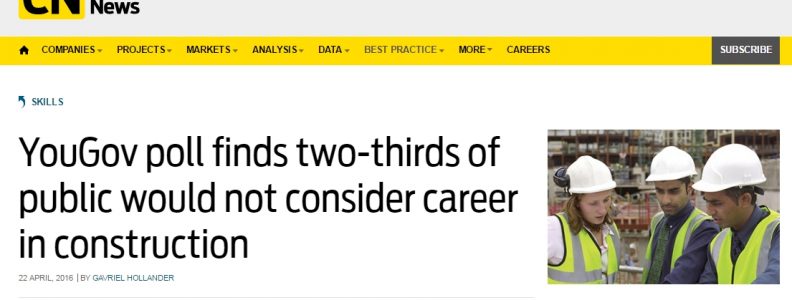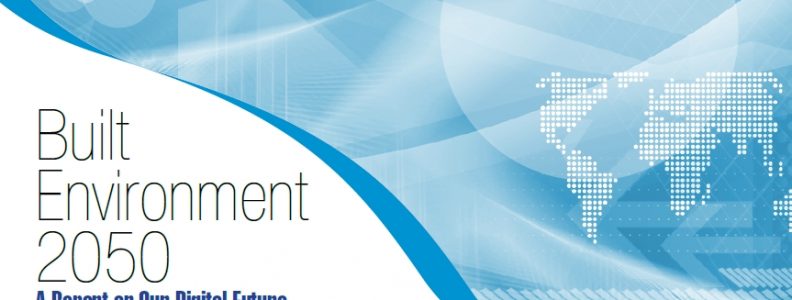We need to tackle some of the fundamental issues in the construction industry before we can effectively change “the image of construction”, and wider sharing of data should be part of the solution.
“The image of construction” has featured heavily this week for me (to be honest, it often does – as previous posts probably show).
On Tuesday, I was part of a CIMCIG-led roundtable discussion in London with Mark Farmer, the consultant helping the Construction Leadership Council to address issues relating to construction skills and the future needs of the industry (see gov.uk news release).
Yesterday I joined a panel discussion at the Women in Construction and Engineering Awards day, part of which focused on how current images of construction and engineering make them unattractive to potential entrants, parents, teachers and even careers advisors.
And today, I have been reading in Construction News (YouGov poll finds two-thirds of public would not consider career in construction) about a survey for Construction United showing:
- more than half of the public view construction work as ‘strenuous’ or ‘dirty’, with just 11 per cent saying it was ‘exciting’
- 23 per cent viewed construction work as creating ‘mess, traffic and inconvenience’
- people do not see the industry as academically driven, with 41 per cent saying it was one the least likely sectors to require a further or higher education qualification
Such survey findings are nothing new. They simply confirm that the “image” problem persists year after year despite numerous campaigns to change popular perceptions. Industry insiders maintain that we need to “present how fantastic it is to work in construction and change some of those perceptions… all of us who work in construction love it; we just haven’t been very good collectively at expressing that message” (to quote Suzannah Nicol of Build UK).
To change the image, first change construction
At this week’s CIMCIG meeting, I repeated my view that the “image of construction” is a symptom of a more deep-rooted reputation issue. Bluntly, the industry’s reputation is not just the result of what it says and what others say about it, but – importantly – about what it does and how it behaves.
The reality, evidenced in report after report (read my Ethos blog post: Building a better built environment industry), is that the UK construction industry has for decades been recognised as:
- overly-complex, fragmented and price-fixated in its procurement approaches
- adversarial in its supply chain relations
- poor in its payment practices
- wasteful in its project execution
- conservative in its adoption of new technologies, and
- short-termist and reactive in its approach to human skills development and R&D.
Add to this the ‘macho’ culture on many sites and the painfully slow progress in addressing diversity issues (see: Let’s share more data on skills and diversity), is it any wonder that the industry currently known as construction has an image problem?
At a Constructing Excellence conference in 2014, I said the industry needed to stop thinking of itself as a monolithic entity and start to identify changes it could make across its many disciplines, and then get them communicating, running long-term, integrated, pan-sector campaigns, and working collaboratively with partners, trade bodies and (most importantly, perhaps) its customers and end-users. Currently though, we seem to be more focused on trying to fix the image, rather than fixing the reasons behind that image.
It’s not just about campaigns
CITB’s Jane Gleave was at the CIMCIG meeting and talked about the GoConstruct campaign (read my pwcom post); last month I noted the launch at Ecobuild of Build UK’s new video; and this week’s story in Construction News (which launched its own #LoveConstruction campaign in July 2013) is based on a poll undertaken for yet another campaign, Construction United, launched in February 2016 and building towards a week of events in October.
And while we’re talking about “image”, to me it is unfortunate that the campaign’s home page perpetuates a view of construction as site-based. Efforts are being made by the Chartered Institute of Building, among others, to get government agencies to accept wider definitions of construction that take account of the inputs of product manufacturers and of professions such as architects, engineers and quantity surveyors, according to a Construction Index report today. We also tend to underplay the key roles played in many construction businesses by accountants, lawyers, marketing, PR, HR and IT people, plus a myriad of administrators.
Nonetheless, Construction United does recognise that there is already an industrial strategy looking to address some of the underlying problems:
“Construction 2025 identified a number of areas that needed addressing, so Construction United aims to bring everyone with a vested interest in construction together to raise awareness of the key issues facing the sector, including image, skills gaps and the wellbeing of employees at all levels.”
It’s not just about raising awareness of the key issues, but actually doing something about them. Construction 2025 and the Government Construction Strategy 2016-2020 (see previous post: Tackling skills gaps – can we learn from BIM?) prescribe a suite of changes aimed at making construction and the built environment more cost effective and sustainable. The BIM programme has shown that the industry can collaborate to tackle the underlying fragmented structures, silo-based attitudes, anti-collaborative behaviours and out-dated technologies – and BIM shows we can be sophisticated users of technology and data, not just stereotyped wielders of bricks, concrete and steel.
If government can inspire such changes in project delivery, surely it can work with industry so that construction skills provision also benefits from even more collaboration and more sharing of data? Incidentally, the UK was confirmed yesterday as the world’s leader in Open Data (see the 3rd Open Data Barometer report).
 Where the Work Is
Where the Work Is
Through the SkillsPlanner project, we see some signs this is beginning to happen. Yesterday, for example, SkillsPlanner programme director Rebecca Lovelace attended an Institute for Public Policy Research launch of a jobs and skills tool called Where The Work Is. This jobs data platform draws on historic data on over 1.5 million jobs posted online by employers across all sectors in the UK from 2012 to 2014 and normalised against government data on vacancies, and we have incorporated some of the same datasets into our developing SkillsPlanner data catalogue. Clearly, we would welcome more contributions of data to help improve our understanding of the construction skills supply and demand challenges.
Incidentally, Where The Work Is also provided supporting data for a report, “Jobs and Skills in London: Building a More Responsive Skills System in the Capital” (download PDF), which recommended that the Greater London Authority might be given a more active role in funding adult education providers, and be given the capability to shift to a results-based funding model for adult skills in the future. This fits neatly with some of the aspirations we have for SkillsPlanner – if we can demonstrate its success in construction, we feel its data-driven approach can be applied to many other sectors of the economy too.



 “The possibilities of billions of people connected by mobile devices, with unprecedented processing power, storage capacity, and access to knowledge, are unlimited. And these possibilities will be multiplied by emerging technology breakthroughs in fields such as artificial intelligence, robotics, the Internet of Things, autonomous vehicles, 3-D printing, nanotechnology, biotechnology, materials science, energy storage, and quantum computing.
“The possibilities of billions of people connected by mobile devices, with unprecedented processing power, storage capacity, and access to knowledge, are unlimited. And these possibilities will be multiplied by emerging technology breakthroughs in fields such as artificial intelligence, robotics, the Internet of Things, autonomous vehicles, 3-D printing, nanotechnology, biotechnology, materials science, energy storage, and quantum computing. What also seems to be lacking is a more wide-ranging and longer-term debate about future digital skills. One exception is SkillsPlanner collaborator
What also seems to be lacking is a more wide-ranging and longer-term debate about future digital skills. One exception is SkillsPlanner collaborator 

